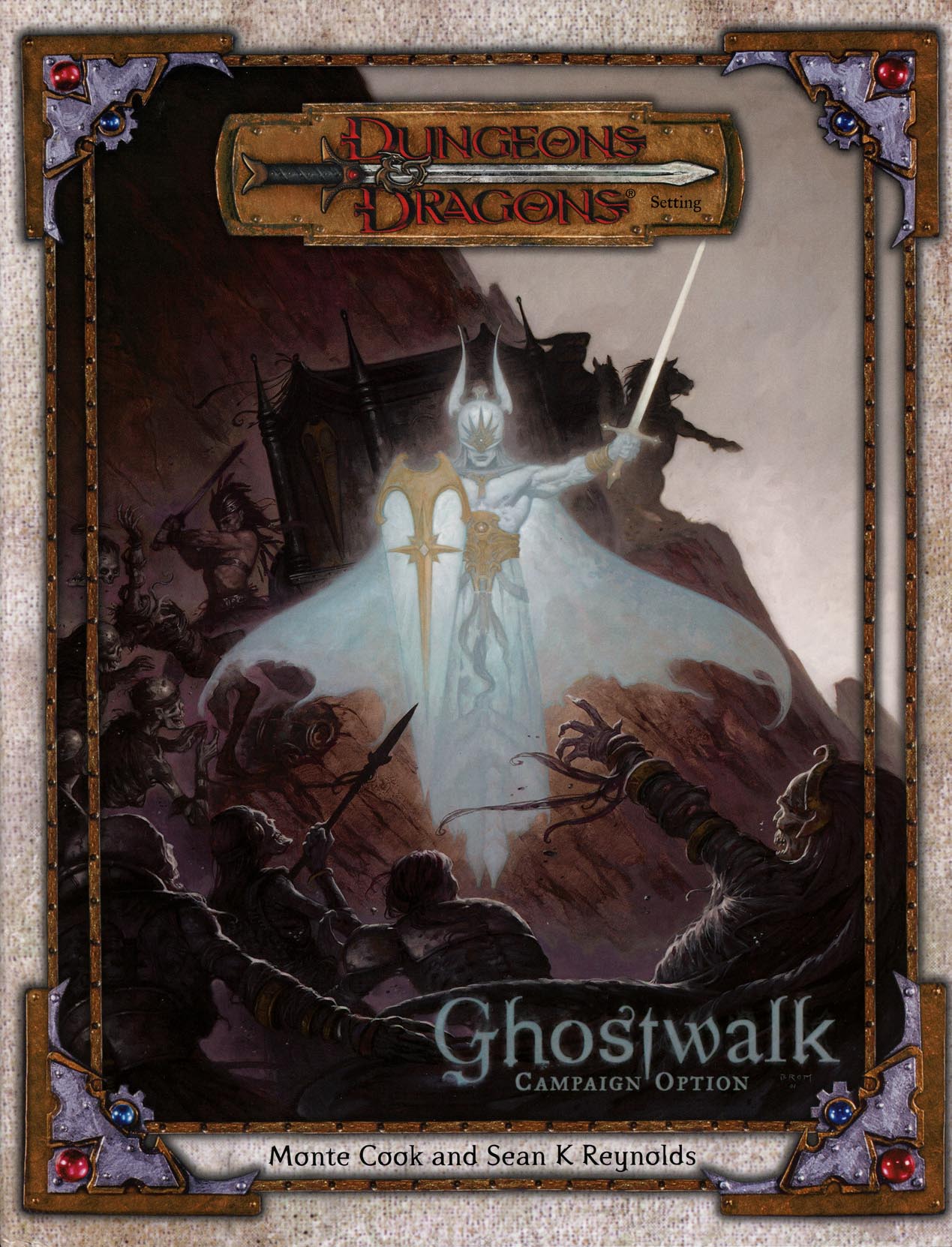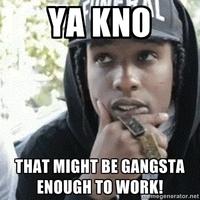OSSR: Ghostwalk
Posted: Thu Jan 02, 2014 8:24 pm
OSSR: Ghostwalk
Campaign Option
 Yes, it says Sean K Reynolds. Be afraid.
Yes, it says Sean K Reynolds. Be afraid.
So it's a new year, and now Ghostwalk is more than 10 years old. So let's bust out the booze and start the reviewing of 2003's experiment with reviving the “campaign option” series: Ghostwalk. The campaign option series was thing that happened in the 90s, where weirder setting ideas were given single-book or single-box-set treatment. They were called “campaign option” to stress the optionality of all of it. Which considering that this was fucking 2nd edition and the entire skill system was considered “optional” meant that these things were really optional.

This is the only thing in the campaign option series anyone actually remembers.
Ghostwalk came out in June of 2003, which is coincidentally the month that 3.5 D&D came out. This book doesn't really say what edition it's for, but it's actually 3rd edition. Classes have a Scry skill to spend points on, fucking deal with it. This is fairly odd, since obviously the 3.5 previews in Savage Species had come out four months earlier, indicating that most of the major changes for 3.5 were known by people working at WotC for months. The logical conclusion is that Ghostwalk was in the pipeline for a long, long time. Monte may have been sitting on early drafts of this thing in 2nd edition days.
In the credits section, the book tells you that it is going to be using stuff from the Forgotten Realms. It mentions some generic books, but also such books as the Forgotten Realms Campaign Setting and Magic of Feyrun. These are setting specific books, and you might think that this is because the book is tied into the Forgotten Realms. You'd be wrong. This book is about a standalone campaign setting with its own afterlife stuff that is wholly incompatible with the soul wall and all that Forgotten Realms garbage. What's really going on here is that those two books had Sean K Reynolds as a contributing author and so does this book. So at various points he felt it was less work to simply reuse stuff he had already gotten published. Well, let's go – this bourbon won't drink itself.
The Introduction

Ghostwalk centers around one big conceit: there's an area where ghosts are solid (the campaign takes place there), and player characters get to have two “lives” in the video game sense. The first as living people, and then once they die they get to play their second life as a solidified ghost. The city that the campaign is in is named “Manifest” because ghosts are manifested there, and now I'm drinking. It's like a fermented mash miracle. Ghosts are solid here because it's close to the big hole in the ground that leads to the land of the dead. For some reason, many ghosts don't want to jump down a giant hole in the ground that is called “The Veil of Souls” and thus there's a city with a lot of ghosts in it, and it has an unimaginative name.
That's about all you get before it starts telling you about how different character classes are handled in the game's setting. It comes out swinging by reminding us that “Barbarian” is a terrible name for a character class, and an even worse name for a character class that is supposed to be “core.”
Most of the other class descriptions are slightly less horrible, mostly telling you that the class is indeed available to be played. It does go somewhat off the rail with the Clerics and Paladins, where it drops that this book is insisting on using its own stupid pantheon. How stupid, dare you ask? So stupid that the gods being worshiped are characters that Sean K Reynolds made for new players to use in convention games. Yes, really. You're apparently supposed to worship Aluvan and Dracanish. It was a little bit dickish when Gygax pulled this stunt in the early eighties, no idea why Sean K Reynolds thought it would go over well in 2003. The page ends with two paragraphs reminding you that some spells may work differently (or not at all) on ghosts, and that spellcasters should probably read the part of the book that talks about that shit.
The monsters section is mostly a tirade about how it's fuckin D&D and you're gonna fight some monsters. Also, that the main villains of the setting are Yuan-Ti, because why not? The big WTF?! comes right in here:
Next up: All About Ghosts!
Campaign Option

So it's a new year, and now Ghostwalk is more than 10 years old. So let's bust out the booze and start the reviewing of 2003's experiment with reviving the “campaign option” series: Ghostwalk. The campaign option series was thing that happened in the 90s, where weirder setting ideas were given single-book or single-box-set treatment. They were called “campaign option” to stress the optionality of all of it. Which considering that this was fucking 2nd edition and the entire skill system was considered “optional” meant that these things were really optional.

This is the only thing in the campaign option series anyone actually remembers.
Ghostwalk came out in June of 2003, which is coincidentally the month that 3.5 D&D came out. This book doesn't really say what edition it's for, but it's actually 3rd edition. Classes have a Scry skill to spend points on, fucking deal with it. This is fairly odd, since obviously the 3.5 previews in Savage Species had come out four months earlier, indicating that most of the major changes for 3.5 were known by people working at WotC for months. The logical conclusion is that Ghostwalk was in the pipeline for a long, long time. Monte may have been sitting on early drafts of this thing in 2nd edition days.
In the credits section, the book tells you that it is going to be using stuff from the Forgotten Realms. It mentions some generic books, but also such books as the Forgotten Realms Campaign Setting and Magic of Feyrun. These are setting specific books, and you might think that this is because the book is tied into the Forgotten Realms. You'd be wrong. This book is about a standalone campaign setting with its own afterlife stuff that is wholly incompatible with the soul wall and all that Forgotten Realms garbage. What's really going on here is that those two books had Sean K Reynolds as a contributing author and so does this book. So at various points he felt it was less work to simply reuse stuff he had already gotten published. Well, let's go – this bourbon won't drink itself.
The Introduction

Ghostwalk centers around one big conceit: there's an area where ghosts are solid (the campaign takes place there), and player characters get to have two “lives” in the video game sense. The first as living people, and then once they die they get to play their second life as a solidified ghost. The city that the campaign is in is named “Manifest” because ghosts are manifested there, and now I'm drinking. It's like a fermented mash miracle. Ghosts are solid here because it's close to the big hole in the ground that leads to the land of the dead. For some reason, many ghosts don't want to jump down a giant hole in the ground that is called “The Veil of Souls” and thus there's a city with a lot of ghosts in it, and it has an unimaginative name.
That's about all you get before it starts telling you about how different character classes are handled in the game's setting. It comes out swinging by reminding us that “Barbarian” is a terrible name for a character class, and an even worse name for a character class that is supposed to be “core.”
That is literally the first fucking sentence that mentions Barbarians, the Varlin Mountains, or Bazareene. The Varlin Mountains and Bazareene are never mentioned again in any WotC book, and Bazareene doesn't get a proper writeup until page 135. Really I'm not sure how that could have been written to be less informative or helpful than it is. They could have told you something about Varlish culture or what Barbarians were actually about in this setting, but instead they chose to name drop a bunch of places no one cares about. Honestly, does being told that you're probably from the Varlin Mountains in the setting make you more or less likely to play a Barbarian? Answer of course is neither, because those words don't mean anything.Ghostwalk wrote:Barbarians are rare around Manifest, usually hailing from the Varlin Mountains near Bazareene.
Most of the other class descriptions are slightly less horrible, mostly telling you that the class is indeed available to be played. It does go somewhat off the rail with the Clerics and Paladins, where it drops that this book is insisting on using its own stupid pantheon. How stupid, dare you ask? So stupid that the gods being worshiped are characters that Sean K Reynolds made for new players to use in convention games. Yes, really. You're apparently supposed to worship Aluvan and Dracanish. It was a little bit dickish when Gygax pulled this stunt in the early eighties, no idea why Sean K Reynolds thought it would go over well in 2003. The page ends with two paragraphs reminding you that some spells may work differently (or not at all) on ghosts, and that spellcasters should probably read the part of the book that talks about that shit.
The monsters section is mostly a tirade about how it's fuckin D&D and you're gonna fight some monsters. Also, that the main villains of the setting are Yuan-Ti, because why not? The big WTF?! comes right in here:
Wait, what? Can I play an Elf or not? Do I not get a soul form second life if I do? What the actual fuck is going on here? There's a whole section on how “Fighters are common most everywhere you go, and in Manifest, it's no different.” but there's no bit of the introduction given over to whether and how the basic races fit in. And since you just casually dropped the bomb that two out of six of the core races have a different set of afterlife rules in a paragraph ostensibly about monsters, maybe you should have fucking done that. Anyway, don't be overly alarmed, because when you get to page 90 of this fucking book, they will bother to tell you that actually Elves just get called to the Spirit Wood, which is a forest next to Manifest, instead of passing through the city itself, and that entire detail is pretty much completely pointless. But in the entire 85 page intermediary it is exceedingly unclear whether you get to take advantage of the extra life rules as an Elf or not. Really makes this feel like a setting that was written for 2nd edition.Ghostwalk Introduction wrote:The spirits of all intelligent humanoids, except elves and half-elves, come through Manifest when they die.
Next up: All About Ghosts!











